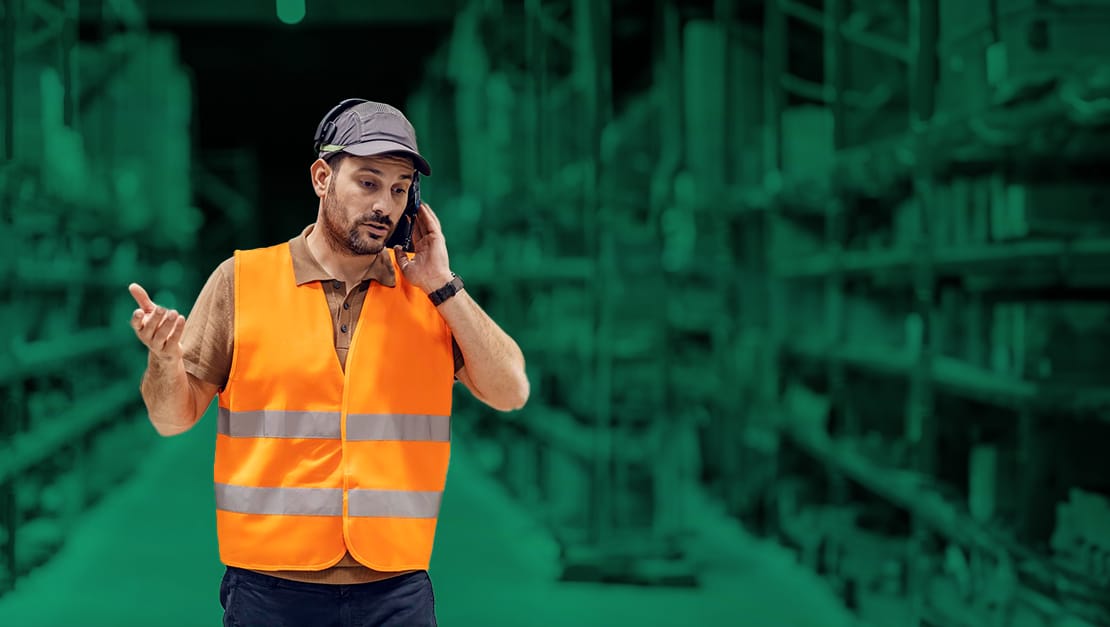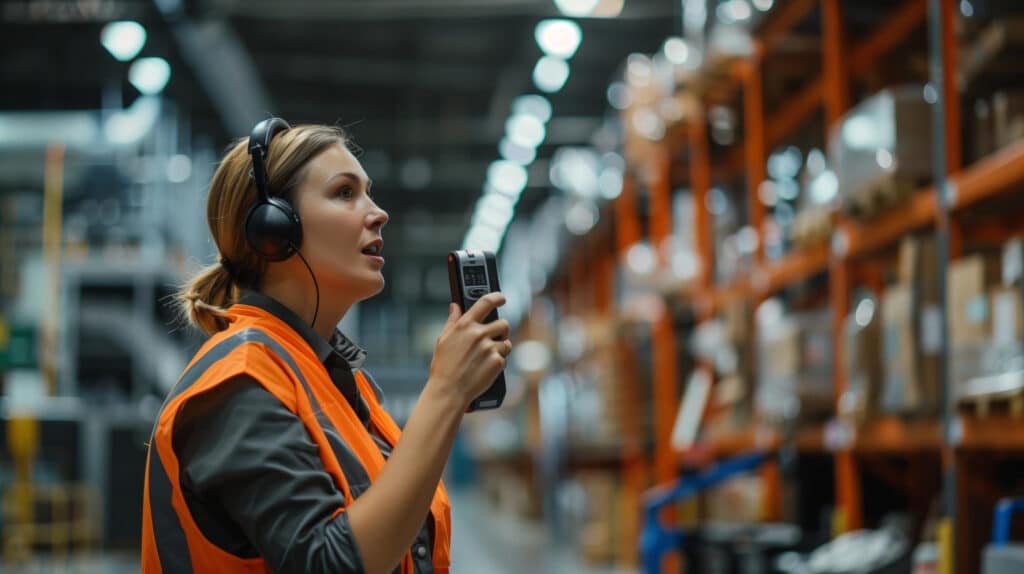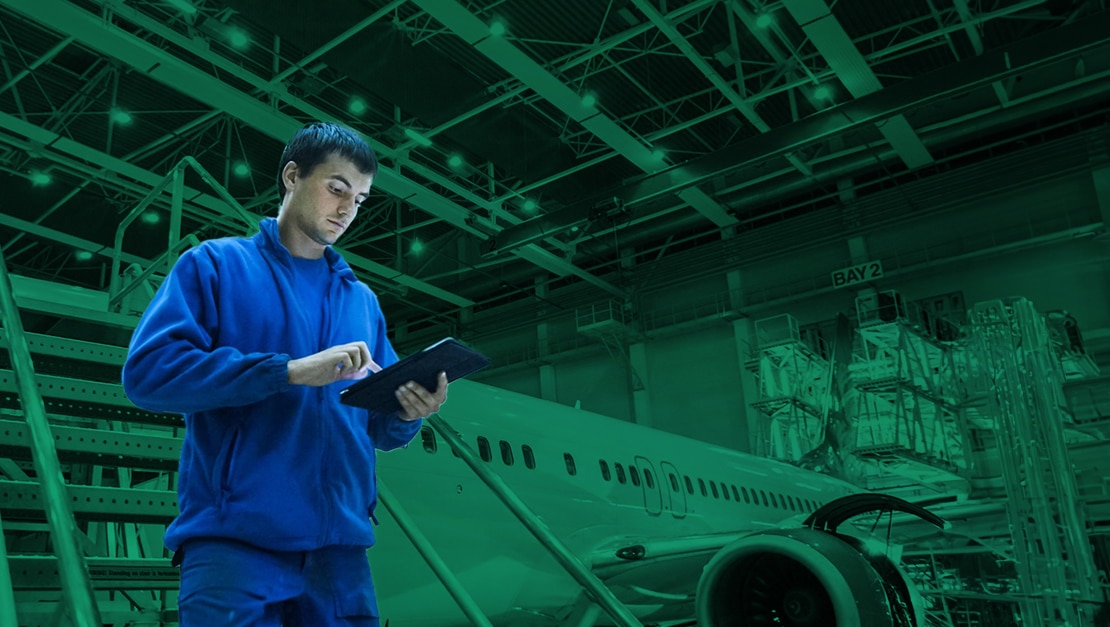Voice picking systems have been in use in warehouses since the 1990s, replacing manual methods like paper-based picking lists and handheld scanners. Voice picking helps warehouse teams work with fewer errors and speeds up order fulfillment.
Also known as voice-directed picking or voice-activated picking, this technology helps warehouse employees work entirely hands-free using voice commands only. By replacing manual paper lists, voice-directed picking solutions can improve warehouse efficiency, accuracy, and safety, which is essential for modern supply chains. When integrated with other technologies, like IoT, AI, or RFID, its abilities can be further enhanced.
In this blog post, we’ll take a closer look at voice picking, its definition, benefits, how the technology is being used in the warehousing industry today, and more.
What Is Voice Picking? Understanding the Technology
Voice-directed picking is a method of order picking used in warehouses where a picker receives instructions through a headset or mobile device and responds verbally. This eliminates the need for handheld scanners or lists, making order-picking workflows move quicker. The process usually involves a few steps:
- A warehouse employee, or picker, wearing a headset receives instructions about items to pick
- The picker can respond to the system to confirm details like SKU, location, items, and quantities
- Using speech recognition technology, the system understands the response and further directs the picker
- Based on the specific system a warehouse is using, the picker may need to say a control code into the headset before picking an item.
Essentially, voice picking integrates with warehouse management systems (WMS) to enable real-time updates and data synchronization. This also helps streamline other warehouse processes like inventory management and additional order fulfillment tasks. When an order is done being picked, the picker notifies the system through speech and the system can trigger the next action, like printing shipping labels.
The Benefits of Voice Picking Technology
Voice picking comes with many benefits across multiple warehouse operations. Additionally, when paired with newer technologies like AI and speech recognition, it can provide even more benefits beyond just order efficiency, which we’ll get into a bit later. Here are a few ways these systems benefit warehouse teams:
- Precision and accuracy: Voice picking helps teams reduce errors by offering clear instructions to pickers, helping them select the right items and quantities, leading to up to 85% better accuracy and increased customer satisfaction
- Efficiency and productivity: By eliminating the need for pickers to refer to paper lists or rely on other workers like operators, picking systems help employees pack orders faster, creating productivity gains in high-volume warehouses, with some technologies resulting in a productivity increase of 36% when it comes to product picking
- Safety and ergonomics: Enabling employees to work hands-free allows them to focus on their tasks, whether it’s picking items off a shelf or handling machinery to help pick and move inventory, reducing the risk of accidents and improving workplace safety
- Real-time inventory visibility: When integrated with a WMS, voice-directed picking can connect with inventory management systems to provide real-time updates on inventory levels and order statuses, allowing warehouse teams to better track stock and reduce stock outs or overstock situations
The Challenges and Limitations of Voice Picking
While there’s no denying the transformative effect voice-directed picking solutions have had on warehouse and logistics teams, it’s not without its challenges. Voice picking has redefined work processes and order fulfillment for countless businesses, however, there are still limitations to keep in mind, such as:
Training and Adoption
Implementing these systems requires training for warehouse staff to familiarize themselves with new systems. Additionally, employees can be resistant to change as these systems can alter existing workflows, which can impact productivity in the short term.
Integration Complexity
Integrating voice picking systems into existing WMSs can be complex and costly. If your legacy systems aren’t capable of integrating with more modern picking technology, it can cause compatibility issues requiring additional resources and expertise to resolve.
Adaptability and Warehouse Environments
Different warehouses have different environments, and voice-directed picking systems may not be suited for all warehouses. Some logistics teams may need to wear protective equipment like noise-canceling earphones or protective gear that can make a headset tricky to add to regular workflows. Adapting existing voice picking systems to new environments can be a challenge.
Maintenance and Support
As is the case with any digital system, it requires ongoing maintenance and support to ensure optimal performance. Voice-picking systems need regular software updates, hardware maintenance, troubleshooting, and more, which isn’t prohibitive but something to take into account when considering which voice-activated system to adopt in your warehouse.
Speech AI vs Voice Picking: What’s Better for Your Warehouse Workflows?
If you’re not already using voice picking in your daily warehouse workflow, you may be wondering if it’s the right technology for you or if you should adopt a different type of voice system, like speech AI technology. While similar in that they both rely on voice to accomplish tasks hands-free, speech AI and voice picking systems aren’t quite the same:
- Voice-directed picking, as we’ve seen, is a specific technology that helps warehouses in order picking and fulfillment. It serves one purpose and the technology can’t be applied to other areas of logistics management.
- On the other hand, speech AI refers to entire artificial intelligence systems that can understand and generate human speech and can be used for a variety of needs, such as virtual assistants, inspection completion, workflow automation, gathering data and insights, transportation optimization, and more.
In other words, speech AI systems offer warehouse teams a suite of tools and possibilities to work with their voice to accomplish tasks, including picking items for order fulfillment, whereas voice picking is only used to fulfill one type of task.
When considering which technology to adopt for your business, it comes down to what your company goals and current and future needs are. If all you need is a picking system to optimize order fulfillment, voice technology is a safe bet.
On the other hand, if you want to optimize all areas of your warehouse operations while reducing reliance on resources and increasing efficiency across the board, speech AI will offer a lot more opportunities. aiOla is a great solution for speech AI software that will provide an all-encompassing path to improving warehouse efficiency.
Adopting Speech AI for Warehouse Operational Optimization with aiOla
As an advanced speech AI technology, aiOla can enable warehouse teams to perform a lot more tasks than just item picking.
With aiOla, warehouse and logistics teams can:
- Ensure warehouse operations are safe and hands-free, suitable for all noise settings, seamlessly integrating with any WMS or systems.
- Accelerate pallet processing with verbal confirmations and AI-driven workflows, functioning effortlessly across various noise levels.
- Collect data in real-time to identify trends and enhance productivity and forecasting, without bulky hardware or noise canceling.
- Minimize manual data entry errors through speech-activated reporting, adaptable to any noise environment.
- Streamline manual inspections of essential machinery with efficient speech-driven updates.
- Share immediate, speech-reported alerts with the warehouse team, ensuring smooth communication in any setting.
- Foster team collaboration across locations with real-time, speech-logged updates, easily integrating with existing processes.
- Enable frontline workers to use mobile devices through speech, remaining untouched in pockets, even in noisy environments.
aiOla understands over 100 languages as well as any accent, dialect, and industry jargon while operating with a high level of accuracy in any acoustic environment, including noisy warehouses. Teams can rely on otherwise lost speech-based data to inform important business decision-making and to trigger logistics automations and workflows that can help them increase productivity.
While voice-directed picking helps companies improve order efficiency, aiOla facilitates a holistic approach to improving efficiency and productivity in all aspects of logistics and warehouse operations. Teams that have used aiOla have seen a 30% increase in production uptime along with a 90% decrease in manual operations.
Speech AI: Propelling your Warehouse Forward
Voice picking is a great solution for improving order fulfillment, however, that’s where the efficiency ends. Speech AI, by contrast, can completely transform your logistics operations to make workflows a lot more seamless, connected, and intuitive. aiOla is a great solution for companies looking to harness the power of speech to help with everything from order fulfillment to machinery inspection, offering a much more comprehensive solution.
Book a demo with one of our speech AI specialists to see how aiOla can work for your warehouse.









